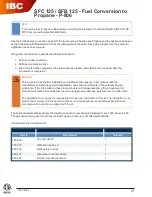
switching from right to left, rotate the tube 90°
clockwise to align the holes with the water
passages in the casting (see Fig. 3). Remount the
flanges and gaskets.
c)
Remove the 5-point well from the right tapping and
the plug or well from the left. Install the well into the
left tapping, and plug the right hand tapping. Use a
thread sealer such as hemp (included in accessory
kit) and pipe thread sealant when installing these
fittings.
Note: Supply and return pipes must be installed on
same side of boiler.
2.3
Location
The boiler must be installed in an indoor space not
subject to freezing temperatures. The boiler should be
located near a floor drain. The boiler must be installed
on a solid level foundation capable of supporting the
boiler and piping filled with water.
The boiler casting is shipped fully assembled on a
wooden skid. To remove the boiler from the skid, lift it
off using a hoist of sufficient capacity, or use a fork lift
from the side. Refer to Technical Data, for boiler weight.
Observe maximum allowable floor weight when
positioning boiler.
Never lift boiler using the draw rods. Place the boiler so
that the following clearances to combustible materials
are maintained.
Top:
18˝
(457 mm)
Back:
6˝
(152 mm)
Side 1:
6˝
(152 mm)
Side 2:
6˝
(152 mm)
Floor: Non-combustible
Additionally, the following service clearances should be
observed:
Front:
48˝
(1220 mm)
Side:
24˝
(610 mm)
(with supply, return, gas connections and pilot)
Note that these clearances are from the assembled
boiler enclosure. See Fig. 4 for clearances from bare
casting. If a concrete pad is required, refer to Technical
Data, for boiler base dimensions. Boiler must not be
installed on carpeting.
2.4
Combustion air supply
This boiler needs fresh air for safe operation and must
be installed so there are provisions for adequate
combustion and ventilation air. All combustion air must
come from the outside.
5
Fig. 3
Water distribution tube – boiler return
Vertical outlet
Boiler
casting
Gasket
Horizontal outlet
Water distribution pipe
Gasket
Return flange
Fig. 4
Minimum clearances to combustibles – side view
Draft
hood
Boiler
jacket
Boiler
casting
20˝
(508mm)
36
˝
(914mm)
18
˝
(457mm)
Fig. 5
Minimum clearances to combustibles – top view
Boiler
casting
Boiler jacket
8˝
(203mm)
8˝
(203mm)
6˝
(152mm)
6˝
(152mm)






































